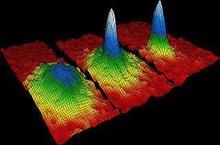 German physicists used potassium for the first time to create a quantum gas below absolute zero. Scientists called this achievement “a stunt for experimentation†and opened the door for the creation of negative temperature materials and new quantum devices in the future, which will help reveal many of the occult forces in the universe.
German physicists used potassium for the first time to create a quantum gas below absolute zero. Scientists called this achievement “a stunt for experimentation†and opened the door for the creation of negative temperature materials and new quantum devices in the future, which will help reveal many of the occult forces in the universe. In the middle of the 18th century, William Thompson, the Baron of Kelvin, defined the absolute temperature. Under this regulation, no material temperature can be lower than absolute zero. The absolute temperature of the gas is related to the average energy of the particles it contains. The higher the temperature, the higher the average energy, and the absolute zero is the state where all particle energy of the gas is zero. This is an ideal theoretical state. In the 1950s, physicists encountered more anomalous material systems in their research and found that this theory was not entirely correct.
Ullrich Schneider, a physicist at Ludwig Maximilian University in Munich, explained that technically, people can read a series of temperatures from a temperature curve, but these numbers represent only The probability that the particles it contains are in an energy state. In general, the energy state of most particles is at or near average and only a few particles are in the higher energy state. Theoretically, if this position is reversed, most particles will be in a high energy state and a few particles will be in a low energy state. The temperature curve will be reversed, and the temperature will be from positive to negative and below absolute zero. Wolfgang Kotler, winner of the 2001 Nobel Prize in physics, also demonstrated that there is a negative absolute temperature in the magnetic field system.
Schneider and colleagues achieved this negative absolute zero with supercooled quantum gas at the potassium atom. They use lasers and magnetic fields to keep individual atoms in a lattice. At positive temperatures, the repulsion between atoms keeps the lattice structure stable. Then they quickly change the magnetic field so that the atoms become attracted to each other instead of repelling. Schneider said: "This sudden conversion, which caused the atoms to react too late, suddenly jumped from their most stable state, the lowest energy state, to the highest possible state of energy. Like you are crossing the valley and suddenly discovered Already on the mountain."
At positive temperatures, this reversal is unstable and atoms can collapse inwards. They also adjust the potential trap laser field at the same time, enhancing the energy to stabilize the atom in situ. In this way, the gas achieves a transition from above absolute zero to below absolute zero, which is about a few billionths of a degree Kelvin.
Kotler is currently a professor of physics at the Massachusetts Institute of Technology. He called this latest achievement an "experimental stunt." In the lab, anomalously high energy states are difficult to generate at positive temperatures, but they become stable at negative absolute temperatures—"just as if you could put a pyramid upside down firmly and not worry about it. It will fall," Ketterer pointed out, the technology allows people to study these abnormally high energy states in detail, "may also be a way to create new material forms."
Achim Rosch, a theoretical physicist at the University of Cologne, Germany, said that if they can really create these material systems, they will show strange behavior. According to his colleagues, under normal circumstances, the atomic cloud will be pulled down by gravity. If a part of the cloud is at a negative absolute temperature, some atoms will move upwards, which is obviously against gravity.
Negative absolute temperature gas can also simulate "dark energy." Dark energy is the force that propels the universe to explode and resists the inward pull of gravitation. Schneider pointed out that in the gases they generate, the atoms attracting each other also tend to collapse inward, but the negative absolute temperature can restrain them from moving inwards and remain stable. The bizarre phenomenon that is prevalent in this universe can now be seen in the laboratory and is worth further study by cosmologists.
Underground Type Indicator Post,Underground Type Indicator Post,Fire Hydrant Valve
Butterfly Valve Ball Valve Co., Ltd. , http://www.nsbutterfly-valve.com